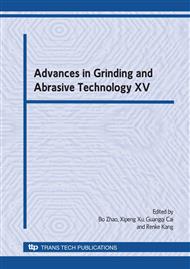p.279
p.284
p.289
p.295
p.300
p.306
p.311
p.316
p.321
Power Spectral Density and Cross Correlation Function Analysis of Finished Surface by Abrasive Jet with Grinding Wheel as Restraint
Abstract:
The abrasive jet finishing process with wheel as restraint is a kind of compound precision finishing process that combined grinding with abrasive jet machining, in which inject slurry of abrasive and liquid solvent to grinding zone between grinding wheel and work surface under no radial feed condition when workpiece grinding were accomplished. The abrasive particles are driven and energized by the rotating grinding wheel and liquid hydrodynamic pressure and increased slurry speed between grinding wheel and work surface to achieve micro removal finishing.In the paper,the finished surface morphology was studied using Scanning Electron Microscope (SEM) and microscope and microcosmic geometry parameters were measured with TALYSURF5 instrument respectively. According to the metrical results, the surface topographical characteristics were evaluated with correlation function and PSD (Power Spectral Density) of random process about machined surface before and after finishing. The results show that longitudinal geometry parameter values of finishing machining surface were diminished comparing with ground surface,and the mean ripple distance was decreased and, ripple and peak density were increased. Furthermore, the finished surface has little comparability compared to grinding machining surface.The isotropy surface and uniformity veins at parallel and perpendicular machining direction were attained by abrasive jet precision finishing with grinding wheel as restraint and the surface quality is improved obviously.
Info:
Periodical:
Pages:
300-305
Citation:
Online since:
September 2009
Authors:
Price:
Сopyright:
© 2009 Trans Tech Publications Ltd. All Rights Reserved
Share:
Citation:


